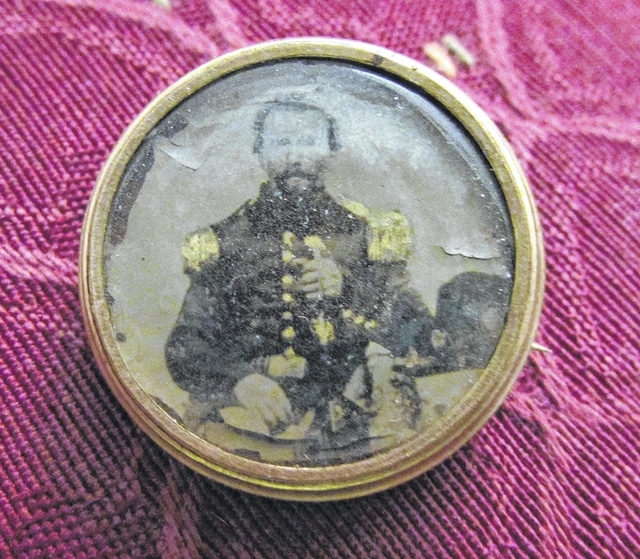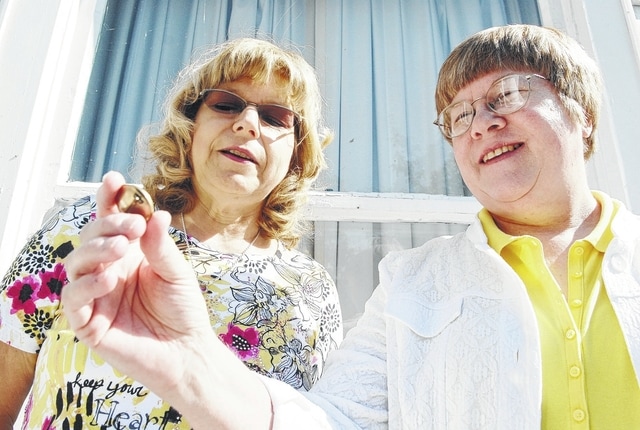

Editor’s note: This is one of a series of articles that will run until Labor Day in advance of the Shelby County Historical Society’s Week of Valor, including the return to Sidney of the Vietnam Memorial replica wall and a Field of Valor featuring American flags in Custenborder Park. Flags for the Field of Valor can be purchased by calling 498-1653. The project commemorates 2015 as the anniversary of the beginning or end of several U.S. armed conflicts. This series will include stories about most of America’s wars. Today, a local resident gives her account of her ancestor’s life during the Civil War.
When I was quite young, my grandmother put in my hands a fascinating round pin, about the size of a quarter. Inside its golden frame was the photograph of a soldier in a dark uniform. It was an old tintype photograph, the kind you see in those novelty photo kiosks where everyone is given a costume to wear, except this costume was real.
The soldier in the pin was my great-great-grandfather.
The photograph looked like those taken by Matthew Brady, the famous photographer who documented the life of Abraham Lincoln and the War Between the States. No matter its origin, it was the start of my journey of learning about my ancestor, Lt. Col. Peter Dister, of the 58th Ohio Volunteer Infantry.
Throughout my growing-up years, every time we made a trip to Memorial Hall in downtown Dayton for a musical or theatrical production, we visited yet another reminder of the sacrifice of “The Colonel.” Behind the door on the west wall of the lobby hangs a 5-foot high bronze plaque dedicated to Lt. Col. Peter Dister, who fought for the Northern cause in the “War of the Rebellion” and gave his life for his country.
The plaque erroneously reports that Dister died in the Battle of Vicksburg, a fact that we all believed until a researched and documented booklet written by my great-uncle, Clarence Soehner, in July of 1921, was found by members of the Soehner family. In reality, Dister lost his life at Chickasaw Bayou, Mississippi, several months before the regiment reached Vicksburg. Apparently, those who erected the plaque in 1911 felt that Vicksburg, a well-known battleground, was a more fitting backdrop for the demise of a brave son of Dayton like Col. Dister.
Great-Uncle Clarence wrote the booklet to preserve the history of the Ohio 58th Volunteer Infantry and one of its leaders, his grandfather. Clarence’s mother, Louise Dister, who married Oscar Soehner, was one of the three children of Peter and Catherine Dister. Clarence, my grandmother’s brother, actually traced the route and spoke to living veterans of the battles to document the history of the regiment in which his grandfather served. Detailed reports of each battle as the group marched from Ohio to Louisiana are captured in his account, which is now preserved in the historical archives at Wright State University.
When the war began, 11 companies of volunteers from the Miami Valley merged with other Ohio companies to form the 58th. According to family lore, the 34-year-old Dister first asked permission from his wife, Catherine, to join the war effort.
“Not only will my children thank me,” he reportedly said, “but my children’s children’s children.” It was my generation of whom he spoke, although that may have been my grandmother’s editorializing to bring home the point.
Since Dister, only a captain at the time, had three months’ previous military experience with the First Ohio Volunteer Infantry, he and two superior officers were given the task of instructing the entire regiment. Even the high-ranking officers had little military experience, so Dister was soon promoted to major.
Following appearances at rallies and inaugurations, the 58th left Cincinnati on Feb. 13, 1862, onboard two canal boats, the Tigress and the Decatur, and trekked down the Ohio River to the Tennessee River to Paducah, Kentucky.
The boats were ordered to move up the Cumberland River in the direction of Fort Donelson, where the soldiers would disembark. Marching through the woods, only four miles from camp, the regiment saw for the first time wounded soldiers walking or being carried to the rear.
Ordered to the firing line, the regiment took position in thickly timbered woods. After sleeping on frozen ground, using their knapsacks as pillows, they awoke covered with 3 inches of snow. Companies A and B advanced as the balance of the regiment followed about 200 yards. The skirmishers soon reported the approach of a large force of the enemy. Dister gave the command, “Lie down.” Obeying, the front line went down, the rear rank kneeling, rifles at the ready. Terrific rifle fire followed, answered by heavy volleys from the rifles of the 58th.
More battles followed at Shiloh, Corinth and other locales, resulting in a terrible loss of men on both sides. Freezing cold weather and hunger added to the misery. As they drove the enemy toward the south, the members of the 58th survived on rations left by the rebels, using their tents and equipment until their own supplies arrived.
On Dec.29, 1862, the 58th was joined by the 76th Ohio Infantry and the 31st Missouri Infantry to face the formidable challenge of Rebel artillery at Chickasaw Bayou, Mississippi. Swimming their horses across the bayou, the Union soldiers faced an enemy force of 300 to 500 men supplying a heavy volley of musketry from a line of rifle pits, constructed along the levee on the opposite shore.
Crossing the deep, muddy bayou amid a hail of bullets and shrapnel, Dister lost his horse in the quicksand but continued to command his company on foot. As he waved his sabre and called, “Forward 58th Ohio,” he was shot in the head and fell backward, dead, at the feet of his men. He was not alone, as more than 35 members of the 58th lost their lives that day, and many others were wounded or captured.
Col. Dister was buried where he fell, but several months later, his body was brought back to Dayton by his brother, Joseph, a lieutenant who also served with the 58th.
A funeral service was held at Emmanuel Catholic Church, and he was buried in St. Henry Cemetery with military honors. Years later, his remains were moved again to the family plot in Calvary Cemetery in Dayton, next to his beloved wife, Catherine, who died in 1910. Today, as part of an ongoing project at the cemetery to recognize war heroes, a sign marks his gravesite and pays tribute to his military service.
The legacy of Peter Dister’s patriotism and love of country is something that I began to understand at a young age when a gold pin was placed in my hand, the pin that bears the face of a man I never met but who is well-known to me as “The Colonel.”



